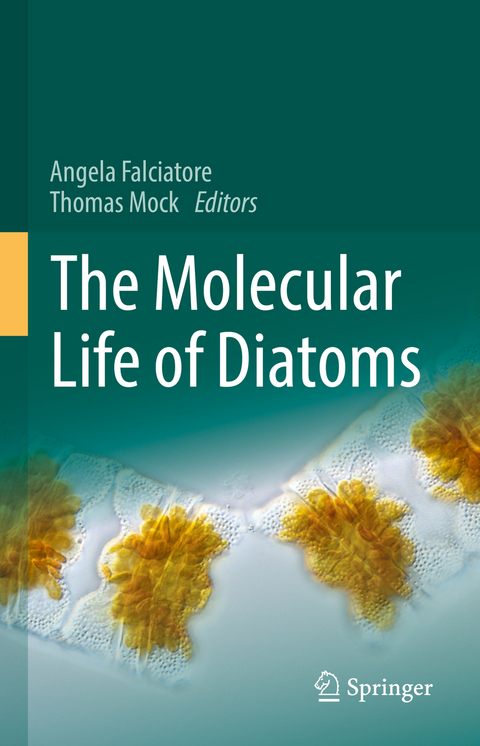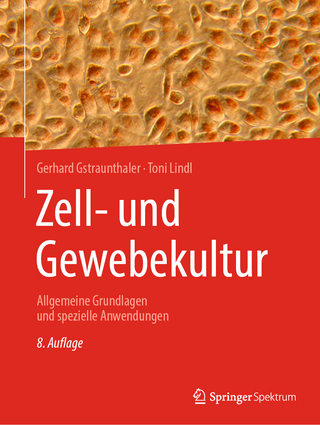
The Molecular Life of Diatoms
Springer International Publishing (Verlag)
978-3-030-92498-0 (ISBN)
Diatoms are the most species rich group of algae, and they contribute about 20% of annual global carbon fixation. They play major roles in ocean food webs and global biogeochemical cycles. They are also a target of the biotechnology industry because of their nano-patterned silica cell wall and high lipid content. Diatoms have received increasing attention as more genomes became available and because of the development of genome editing tools such as the CRISPR/Cas9 technology, which has made diatoms as genetically tractable as well-established biological model species.
This book provides an overview on diatom molecular biology. It brings together international leading experts in the field to discuss the latest data and developments from genes to ecosystems. As the understanding of diatoms is currently experiencing a step change, it is critical to allow for synergistic approaches on diverse aspects of diatom biology and evolution. The books offers fundamental insights into the molecular life of diatoms; at the same time new scientific concepts are developed based on the application of the latest molecular tools and genomic information to explore the fascinating lifestyle of diatoms.lt;b>Angela Falciatore is Research Director of the French National Centre for Scientific Research (CNRS). She received a Master's degree in Biological Sciences (1995) at University Federico II of Naples, Italy, where she studied osmotic stress responses in bacteria. Her interest for marine biology stems from the research performed at the Stazione Zoologica Anton Dohrn of Naples (SZN) in Italy, in Chris Bowler laboratory (1995-2001) where she got a PhD in 2002 on the "Molecular studies of environmental signal perception and transduction in marine diatoms". Particularly interested in the dynamic responses of photosynthetic organisms to light, she joined Jean-David Rochaix's laboratory at the University of Geneva, Switzerland for her post-doc (2002-2005), devoted on the chloroplast-to-nucleus retrograde signalling in the green alga Chlamydomonas reinhardtii. Complementary activities at the Okazaki National Institute for Basic Biology, Japan (1997) and at the Carnegie Institution of Washington, Stanford University, USA (2003) contributed to enlarge her expertise in photobiology. In 2005, with a tenure-track position, she started an independent research activity at the SZN, Italy. At the end of 2009, she got a permanent position from CNRS and moved from Italy to France. She established and led the team "Diatom Functional Genomics" in the Laboratory of Computational and Quantitative Biology directed by Alessandra Carbone at Université Pierre et Marie Curie in Paris. Since 2019, she is the Head of the Laboratory of "Chloroplast Biology and Light Sensing in Microalgae", affiliated at the CNRS and Sorbonne Université at the Institut de Biologie Physico-Chimique (IBPC) in Paris.
A major focus of her research has been to establish diatoms as new model systems for marine biology and photobiology by developing genomic resources and genetic tools. Combining physiological, biophysical, biochemical and genome-wide molecular approaches in the diatom model species Phaeodactylum tricornutum, her team has characterized diversified photoreceptors, fostering novel hypotheses on the role of these sensors in controlling growth and adaptive responses in a marine context. She also uncovered the existence of a long-foreseen diatom circadian clock, which controls essential rhythmic processes in these algae. Her team also contributed to disclose some of the diatom specific photoacclimation properties, by identifying critical regulators of photosynthesis that also influence the natural variability of diatoms photoresponses.
Thomas Mock is a Professor of Marine Microbiology in the School of Environmental Sciences at the University of East Anglia (UEA), Norwich Research Park, Norwich, United Kingdom. He obtained his MSc (1998) in Biology with emphasis on Biological Oceanography at the Christian-Albrechts University in Kiel (GEOMAR) and his PhD (2003) at Bremen University (Alfred-Wegener Institute for Polar and Marine Research), Germany. Before joining UEA in 2007, most of his PostDoc research was conducted with a fellowship from the German Academic Exchange Service (DAAD) in the School of Oceanography, University of Washington (E.V. Armbrust lab) in cooperation with the Biotechnology Centre, University of Wisconsin (M.R. Sussman lab), USA. Before he was promoted to Professor (Personal Chair) at UEA in 2014, he was Reader (2012-2014) and had a Research Councils UK Academic Fellowship (2007-2012).The overarching aim of his research is to identify fundamental biological processes that govern the adaptation and evolution of marine microalgae (Phytoplankton) in the oceans with emphasis on diatoms. His group uses genomics (e.g., metatranscriptomics, metagenomics) and reverse genetics tools (e.g., CRISPR/Cas) for selected phytoplankton groups (e.g., diatoms) and natural assemblages from the global upper ocean to understand their evolution, diversity, and adaptation. This work leads to the identification of genes that shap
Part 1: Ecology And Evolution.- Chapter 1: Trait-Based Ecology With Diatoms.- Chapter 2: The Population Genetics And Evolutionary Potential Of Diatoms.- Chapter 3: An Integrated View Of Diatom Interactions.- Chapter 4: Ancient Diatom Dna.- Part 2: Genomics.- Chapter 5: Structure And Evolution Of Diatom Nuclear Genes And Genomes.- Chapter 6: Reconstructing Dynamic Evolutionary Events In Diatom Nuclear And Organelle Genomes.- Chapter 7: Epigenetic Control Of Diatom Genomes: An Overview From In Silico Characterisation To Functional Studies.- Part 3: Cell Biology.- Chapter 8: Life-Cycle Regulation.- Chapter 9: Cellular Hallmarks And Regulation Of The Diatom Cell Cycle.- Chapter 10: Cell Biology Of Organelles.- Chapter 11: Structure And Morphogenesis Of The Frustule.- Chapter 12: Biomolecules Involved In Frustule Biogenesis And Function.- Chapter 13: Silicic Acid Uptake And Storage By Diatoms.- Chapter 14: Adhesion And Motility.- Part 4: Primary Metabolism.- Chapter 15: Photosynthetic LightReactions In Diatoms. I. The Lipids And Light-Harvesting Complexes Of The Thylakoid Membrane.- Chapter 16: Photosynthetic Light Reactions In Diatoms. Ii. The Dynamic Regulation Of The Various Light Reactions.- Chapter 17: Carbohydrate Metabolism.- Chapter 18: Lipid Metabolism In Diatoms.- Chapter 19: Comparative And Functional Genomics Of Macronutrient Utilization In Marine Diatoms.- Chapter 20 Molecular Mechanisms Underlying Micronutrient Utilization In Marine Diatoms.- Part 5: Cell Signalling And Interactions.- Chapter 21: Sensing And Signalling In Diatom Responses To Abiotic Cues.- Chapter 22: An Ocean Of Signals: Intracellular And Extracellular Signalling.- Chapter 23: The Diatom Microbiome: New Perspectives For Diatom-Bacteria Symbioses.- Chapter 24: Diatom Viruses.- Part 6: Genetic And Metabolic Engineering.- Chapter 25: Genetic Engineering In Marine Diatoms: Current Practices And Emerging Technologies.- Chapter 26: Constraint-Based Modelling Of Diatoms Metabolism And Quantitative Biology Approaches.
| Erscheinungsdatum | 13.05.2022 |
|---|---|
| Zusatzinfo | XXIII, 808 p. 104 illus., 86 illus. in color. |
| Verlagsort | Cham |
| Sprache | englisch |
| Maße | 155 x 235 mm |
| Gewicht | 1406 g |
| Themenwelt | Naturwissenschaften ► Biologie ► Mikrobiologie / Immunologie |
| Schlagworte | diatom adhesion • diatom cell biology • diatom evolution • diatom genetic engineering • diatom genomics • diatom interactions • diatom life cycle • diatom molecular biology • diatom motility • Diatoms • diatom signalling • silica biomineralization |
| ISBN-10 | 3-030-92498-X / 303092498X |
| ISBN-13 | 978-3-030-92498-0 / 9783030924980 |
| Zustand | Neuware |
| Haben Sie eine Frage zum Produkt? |
aus dem Bereich


